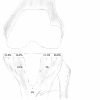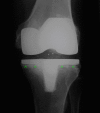Radiolucent lines in low-contact-stress mobile-bearing total knee arthroplasty: a blinded and matched case control study
- PMID: 21714916
- PMCID: PMC3152942
- DOI: 10.1186/1471-2474-12-142
Radiolucent lines in low-contact-stress mobile-bearing total knee arthroplasty: a blinded and matched case control study
Abstract
Background: Low-contact-stress (LCS) mobile-bearing total knee arthroplasty (TKA) (Johnson & Johnson, New Brunswick, NJ; previously: DePuy, Warsawa, USA) provides excellent functional results and wear rates in long-term follow-up analyses. Radiological analysis shows radiolucent lines (RLL) appearing immediately or two years after primary implantation, indicative of poor seat. Investigations proved RLL to be more frequent in uncemented TKA, resulting in a consensus to cement the tibial plateau, but their association with clinical findings and patients discomfort and knee pain is still unknown.
Methods: 553 patients with 566 low-contact-stress (LCS) total knee prostheses were screened for continuous moderate knee pain. We compared tibial stress shielding classified by Ewald in patients suffering from pain with a matched, pain-free control group on blinded X-rays. We hypothesized a positive correlation between pain and radiolucency and higher frequency of such radiolucent lines in the most medial and most lateral zones of the tibial plateau.
Results: Twenty-eight patients suffered from knee pain in total. Radiolucencies were detected in 27 of these cases and in six out of 28 matched controls without knee pain. We could demonstrate a significant correlation of knee pain and radiolucencies, which appeared significantly more frequently in the outermost zones of the tibial plateau.
Conclusion: Our findings suggest that radiolucent lines, representing poor implant seat, about the tibial plateau are associated with knee pain in LCS patients. Radiolucencies are observed more often in noncemented LCS, and cementing the tibial plateau might improve implant seat and reduce both radiolucent lines and associated knee pain.
Figures



References
-
- Buechel FF, Pappas MJ, D'Alessio J. Twenty-year evaluation of meniscal bearing and rotating platform knee replacements. Clin Orthop Relat Res. 2001;388:41–50. - PubMed
-
- Callaghan JJ, Squire MW, Goetz DD, Sullivan PM, Johnston RC. Cemented rotating-platform total knee replacement. J Bone Joint Surg Am. 2000;82-1:705–11. - PubMed
-
- Stiehl JB. World experience with low contact stress mobile-bearing total knee arthroplasty: a literature review. Orthopaedics. 2002;25:s213–17. - PubMed
-
- Buechel FF. My platform moveth and that's all that's needed! Orthopaedics. 2001;24:890–2. - PubMed
MeSH terms
LinkOut - more resources
Full Text Sources
Medical

